#TabLayout
Explore tagged Tumblr posts
Text
A Deep Dive into Android's Advanced UI Components: A Practical Example
Introduction In this tutorial, we will explore the advanced UI components in Android, including TabLayout, BottomNavigation, and RecyclerView. We will dive deep into the technical aspects of these components, including how they work under the hood, best practices, and common pitfalls. By the end of this tutorial, you will have a comprehensive understanding of how to implement these components in…
0 notes
Text
Android TabLayout Example using ViewPager and Fragments - Android Coding by DMTechnolab
Android TabLayout Example using ViewPager and Fragments – Android Coding by DMTechnolab
The package The trap.Simplified coding.androidtablayout; Import Android.Support.The design.Widget.Tablaout; Import Android.Support.v4.Opinion.Observer; Import Android.Support.v7.App.AppCompatActivity; Import Android.The.Bundle; Import Android.Support.v7.Widget.Toolbar; // Implementing the interface ontabsledleastener for our mainactivity // This interface will help swipe ideas public class Main…

View On WordPress
0 notes
Text
android 중급 11강 material design 2 tacademy
original source : https://youtu.be/7ep4effngGc
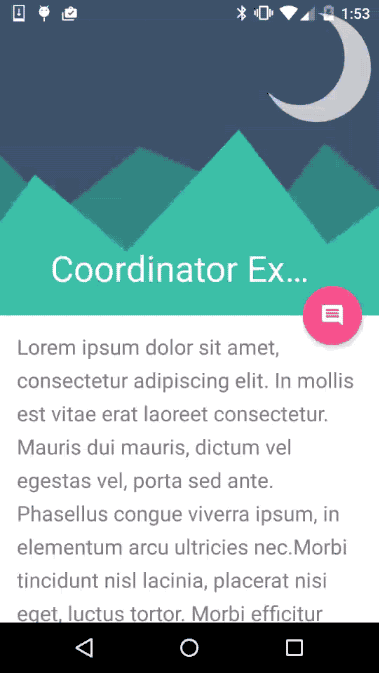
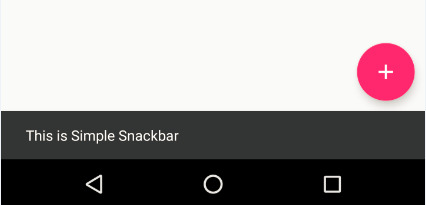
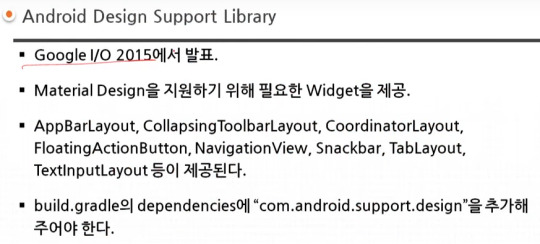
material design이 도입되면서 제공되는 새로운 widgets의 예를 보여주고 있다.
AppBarLayout 부터 TextInputLayout까지 모두 새로운 widgets에 해당한다.

=========================================================
.
.
drawer layout 과 navigation view , navigation drawer 비교
https://stackoverflow.com/questions/44176576/navigation-drawer-vs-navigation-view-which-is-best-and-what-is-the-diffrence

NavigationView를 DrawerLayout과 함께 사용한 방법을 아래서 보여주고 있다.

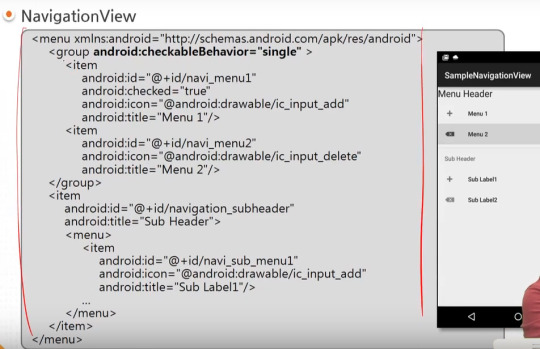
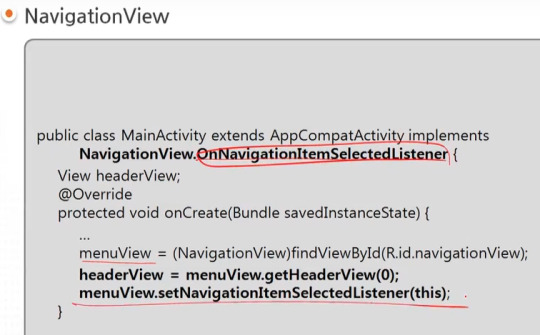
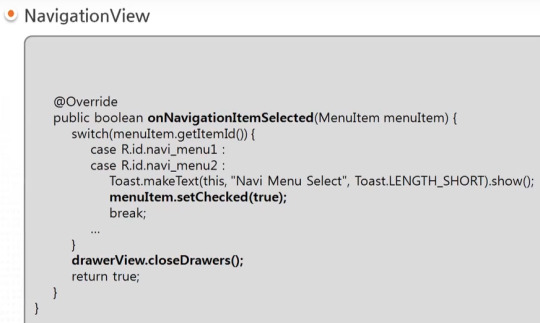
=========================================================
.
.



=========================================================
.
.

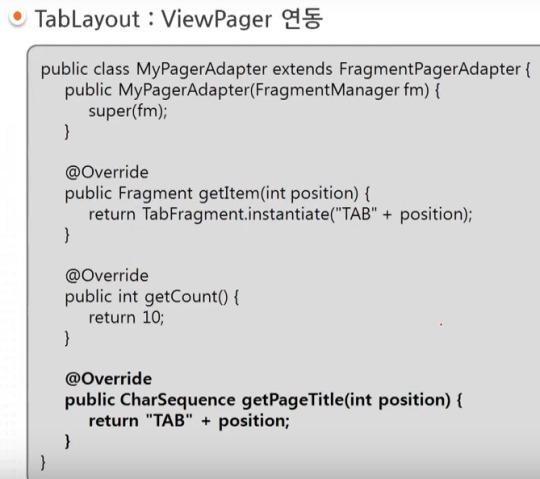
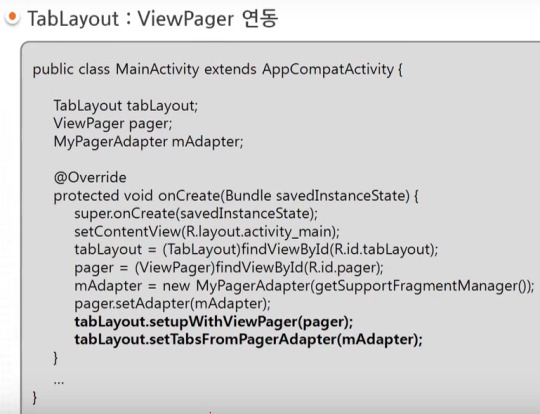
=========================================================
.
.

=========================================================
.
.
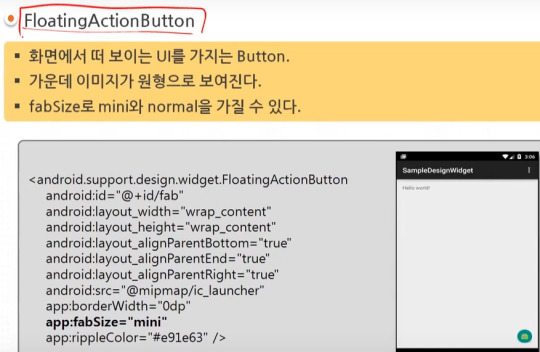
=========================================================
.
.

=========================================================
.
.
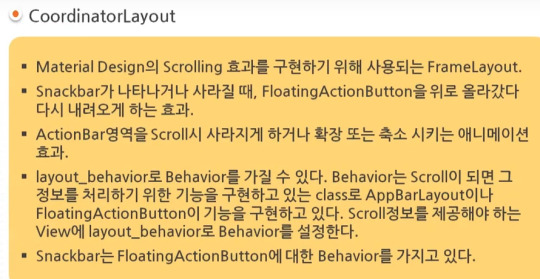
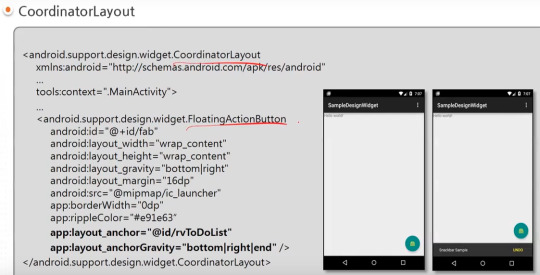
=========================================================
.
.
AppBarLayout과 CollapsingToolbarLayout 참고) 실제 예시 https://youtu.be/wCuM_di5M9Y?t=50


=========================================================
.
.

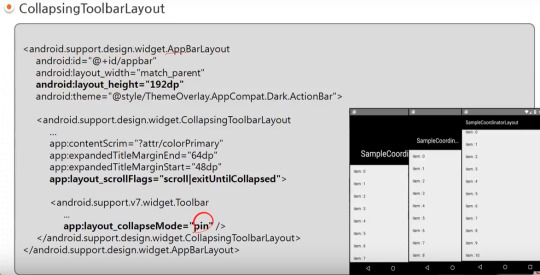
=========================================================
.
.


=========================================================
.
.
android studio 에서 blank activity template을 선택하는 경우 기본적으로 material design widgets이 어느 정도 설정되어서 시작된다.

#android#중급#11강#11#material#material design#tacademy#view#widget#navigationview#tablayout#textinputlayout#toast#snackbar#CollapsingToolbarLayout#AppBarLayout#CoordinatorLayout#tab
0 notes
Text
Pager scrollable tab layout design android development

//in more block } // Create a list of pages int[] pageId = { R.layout.page1, R.layout.page3, R.layout.page5 }; // Define Adapter for ViewPager private class MyPagerAdapter extends android.support.v4.view.PagerAdapter { // Get total number of pages public int getCount() { return pageId.length; } // Get Title of pages @Override public CharSequence getPageTitle(int position) { String[] pageTitle =…
View On WordPress
#androiddevelopment#android development#aviinfo#aviinfo.blog#pager menu#programming#scroll tab#scrollable menu#tab layout#tablayout
0 notes
Photo

tab layout in kotlin https://ift.tt/2EMmL63
0 notes
Text
How to get started with LinearLayout on Android Studio with App?
LinearLayout is among the most important layout managers used in Android Studio. It is employed to lay out the layout's content. It is used by default to arrange the content of Activity and Fragment layout. For beginners, it is sufficient to be able to use it but for advanced developers, it's recommended to use other layout managers like GridLayout and FrameLayout. LinearLayout is also sufficient to design the layout of your application. In this article, I'll describe the fundamental procedures and configurations that you have to be aware of to begin working with LinearLayout.
The 5 Best CCNA Certification Books for 2022
1. What is LinearLayout?
LinearLayout is a layout manager used to build the scrolling list of views. It is similar to a ListView or RecyclerView however, it's not a replacement for these. It's an adaptable layout manager that can be used to create footers and headers as well as navigation or other type of content.
CCNA Routing And Switching All In One Study Guide BOOK
2. Basic steps of using LinearLayout
LinearLayout LinearLayout class is among the most effective layout classes in Android. It can be used to create almost any layout you can think of. One of the most frequent uses of LinearLayout could be creating a scrolling layout that behaves like a list. This layout can be made by creating a LinearLayout using only one child, which is an a ListView. This is the basic design of the scrolling list. You can also create an a scrolling list with TabLayout. TabLayout class. This layout is more suitable to create a list of tabs. LinearLayout is a crucial component of the Android framework. It can be used to create various layouts, such as lists that scroll. This article will show you how to start using LinearLayout using Android Studio.
How To Configure OSPF Single Area On 4 Routers In Cisco Packet Tracer
3. Fundamental configurations and configurations to LinearLayout
This section demonstrates how to make use of the LinearLayout to build the layout with just one column and only one row. The layout is comprised of the following components: TextView, Button TextView and Button. Button. The basic configurations of LinearLayout How To Configure OSPF Multi Area On 4 Routers In Cisco Packet Tracer
4. Conclusion.
To begin using linearLayout using Android Studio, it's helpful to know the different layout classes. Each layout class comes with its own set or utilities and behavior. LinearLayout is one of the most widely used layout classes. LinearLayout is a layout that lays out its children horizontally and vertically. It has multiple children that it can support, which means you can use it to display an item list such as a navigation bar or even a navigation drawer. Another thing to consider about linearLayout is that it does not have any way to connect to its children, other than setsChild() as well as getChild(). This means that you will have to go through each child to access the desired one.
Basic Cisco Router Configuration | Cisco Packet Tracer Tutorial
0 notes
Text
TabLayout With ViewPager2, AppBarLayout and Toolbar
TabLayout With ViewPager2, AppBarLayout and Toolbar
In this article, we will learn to implement Android TabLayout With ViewPager2 AppBarLayout and Toolbar in Kotlin. We will see how to design scrollable ui using those widgets in android application. Let’s have a quick demo of things we want to cover in this tutorial – Output Getting Started We have already seen how to design ui using TabLayout and ViewPager2. We have also noticed that we can n’t…

View On WordPress
0 notes
Link
0 notes
Text
TabScrollAttacher
RecyclerView and TabLayout attacher.

from The Android Arsenal https://ift.tt/36ciNP8
0 notes
Text
Tempo (Silver Edition) Great templates for incredible projects (Templates)
Tempo’s a mobile app templates built on top of material design that’s suitable for Android app developers. It Includes all the default screens with many elements that you would need and it is ready to use, just put your logo, change the colors and call your APIs.
Please note this is the Silver Edition, and you will get just the List Views section, if you want all the Package go to the Gold Edition. Tempo (Gold Edition)



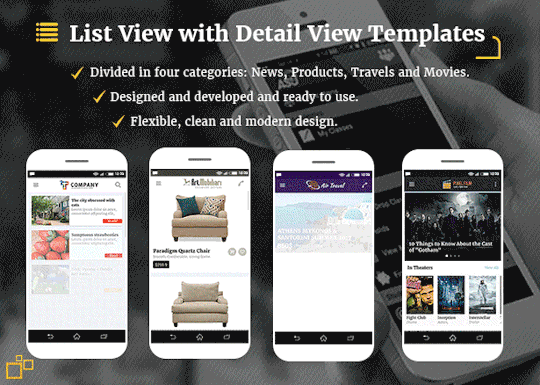

Material Design: following Android Design Guidelines.
Many widgets: Toolbar, CollapsingToolbarLayout, SlidingPaneLayout, DrawerLayout, RecyclerView, SwipeRefreshLayout, FloatingActionButton, TextInputLayout, TabLayout, ViewPager, CardView.
Icons: A wide range of free Google icons and Fontello (Icon fonts).
Activity Transitions: Beautiful transition between Activities (For the list views and details).
Beautiful Animation for RecyclerView: Using Android Animations.
Supporting Tablets and Handsets: Multi-pane layouts on tablets and single-pane layouts on handsets.
Flexible Layout Design: Allows application to adapt to all variations of screen sizes.
Orientation change: Both landscape and portrait orientation supported. (except User login and registration and welcome screen interfaces).
High performance: Optimized for high performance and high-resolution displays.
Caching images: Using Universal Image Loader for displaying and caching images.
Sources and Credits
a wide range of free Material Google icons.
All the dummy graphics from freepik.com.
Material Ripple Effect library.
Universal Image Loader library.
Circle Indicator library.
Circular Image View library.
Merriweather Fonts from fontsquirrel.com.
What you Get:
Full source code in Android Studio.
Documentation.
All screenshots in PDF and PNG types.
Adobe Illustrator app design file organized and layered.
APK file
from CodeCanyon new items http://ift.tt/2Fi7aZL via IFTTT https://goo.gl/zxKHwc
0 notes
Text
tab layout in kotlin
https://ift.tt/2EP7gKN
Tab Layout in Kotlin
TabLayout Example
_________________________________________________________________________
1.fragment_shopping.xml
_________________________________________________________________________
<?xml version="1.0" encoding="utf-8"?>
<androidx.appcompat.widget.LinearLayoutCompat
xmlns:android="https://ift.tt/nIICcg"
xmlns:app="https://ift.tt/GEGVYd"
xmlns:tools="https://ift.tt/LrGmb4"
android:layout_width="match_parent"
android:layout_height="match_parent"
android:orientation="vertical"
>
<com.google.android.material.tabs.TabLayout
android:id="@+id/tab_cart"
android:layout_width="match_parent"
android:layout_height="wrap_content"
app:tabMode="fixed"
tools:ignore="MissingConstraints"/>
<androidx.viewpager.widget.ViewPager
android:id="@+id/vp_cart"
android:layout_width="match_parent"
android:layout_height="wrap_content"
/>
</androidx.appcompat.widget.LinearLayoutCompat>
________________________________________________________________________
2.Init in fragment()
_________________________________________________________________________
import android.os.Bundle
import android.view.LayoutInflater
import android.view.View
import android.view.ViewGroup
import com.commonlibs.base.BaseFragment
import com.justcodenow.bynfor.R
import kotlinx.android.synthetic.main.fragment_shopping_cart.*
class ShoppingFragment : BaseFragment() {
override fun onCreateView(inflater: LayoutInflater, container: ViewGroup?, savedInstanceState: Bundle?): View? {
return inflater.inflate(R.layout.fragment_shopping, container, false)
}
override fun onActivityCreated(savedInstanceState: Bundle?) {
super.onActivityCreated(savedInstanceState)
init()
}
private fun init() {
val fragmentAdapter = PagerAdapter(childFragmentManager)
vp_cart.adapter = fragmentAdapter
tab_cart.setupWithViewPager(vp_cart)
}
}
_________________________________________________________________________
3.Adapter init()
_________________________________________________________________________
import androidx.fragment.app.Fragment
import androidx.fragment.app.FragmentManager
import androidx.fragment.app.FragmentPagerAdapter
class PagerAdapter(fm: FragmentManager) : FragmentPagerAdapter(fm) {
override fun getItem(position: Int): Fragment {
return when (position) {
0 -> {
ItemFragment()
}
else -> {
return SaveFragment()
}
}
}
override fun getCount(): Int {
return 2
}
override fun getPageTitle(position: Int): CharSequence {
return when (position) {
0 -> "Item "
else -> {
return "Save "
}
}
}
}
__________________________________________________________________________
via Blogger https://ift.tt/2EMmL63
0 notes
Text
Calling API when swiping tabs
I have a tab layout with 3 tabs.Each one of the tabs need to display some data from API calling (I’m using Retrofit).
So , I have the main activity when user opens that activity I fetch the data for the first tab then display the view
@Override protected void onCreate(Bundle savedInstanceState) { super.onCreate(savedInstanceState); context = this; if (Application.isConnected()) { getTrips(); } else { Toast.makeText(this , "No internet Connection" , Toast.LENGTH_LONG).show(); setContentView(R.layout.no_internet_connection); } }
So in the success of the API call I inflate the view as below
public void inflatingView () { setContentView(R.layout.activity_mytrip); context = this; tvTitle = findViewById(R.id.tv_title); tabLayout = findViewById(R.id.tablayout); tvTitle.setText("Trips"); tabLayout.addTab(tabLayout.newTab().setText("My Trips")); tabLayout.addTab(tabLayout.newTab().setText("Unclosed Trips")); tabLayout.addTab(tabLayout.newTab().setText("UnApproved Trips")); viewPager = findViewById(R.id.viewpager); myTripAdapter = new MyTripAdapter(getSupportFragmentManager(),tabLayout.getTabCount()); viewPager.setAdapter(myTripAdapter); viewPager.setOffscreenPageLimit(3); tabLayout.addOnTabSelectedListener(new TabLayout.OnTabSelectedListener() { @Override public void onTabSelected(TabLayout.Tab tab) { switch (tabLayout.getSelectedTabPosition()) { case 0 : Log.d("test" , "first tab"); break; case 1 : Log.d("test" , "Second tab"); getTab2Data(); break; case 2 : Log.d("test" , "Third tab"); break; } viewPager.setCurrentItem(tabLayout.getSelectedTabPosition()); } @Override public void onTabUnselected(TabLayout.Tab tab) { } @Override public void onTabReselected(TabLayout.Tab tab) { } }); viewPager.addOnPageChangeListener(new TabLayout.TabLayoutOnPageChangeListener(tabLayout)); }
So , The data for first fragment in first tab is obtained , My problem is with fragment 2 and 3.I only want to call the API when user swiping. As you see above I tried to detect when user swipe to second tab then I call method to fetch data but unfortunately it’s now working.
Do you have any idea on how to do this?
2 Answers
Use this method in your fragment to get visibility state of fragment and then call your api thre.
@Override boolean getUserVisibleHint() { super.getUserVisibleHint() boolean isVisibleToUser=super.getUserVisibleHint() if(isVisibleToUser){ //call api here } return isVisibleToUser }
You should call API’s inside the fragment probably in setUserVisibleHint method in android
boolean _areLecturesLoaded = false; @Override public void setUserVisibleHint(boolean isVisibleToUser) { super.setUserVisibleHint(isVisibleToUser); if (isVisibleToUser && !_areLecturesLoaded ) { loadYourRetrofitData(); //Load your data here _areLecturesLoaded = true; } }
Archive from: https://stackoverflow.com/questions/59044965/calling-api-when-swiping-tabs
from https://knowledgewiki.org/calling-api-when-swiping-tabs/
0 notes
Video
youtube
Android TabLayout Tutorial using ViewPager and Fragments using Sliding T...
0 notes
Text
Android TabLayout With ViewPager2 and Fragment in Kotlin
Android TabLayout With ViewPager2 and Fragment in Kotlin
Till now, we have seen how to use TabLayout with ViewPager. In this tutorial, we will learn how to use Android TabLayout with ViewPager2 and Fragment in Kotlin. Let’s have a quick demo of things we want to cover in this tutorial – Output Getting Started As we already know, TabLayout is used to show different tabs in the application. We have already learnt how to use it with viewPager. In this…

View On WordPress
0 notes
Text
ColorPrefUtil
Easily change theme, background colors, text colors, icon tint colors, custom drawables, NavigationView item colors, TabLayout colors and more...

from The Android Arsenal http://bit.ly/2Bjkihm
0 notes